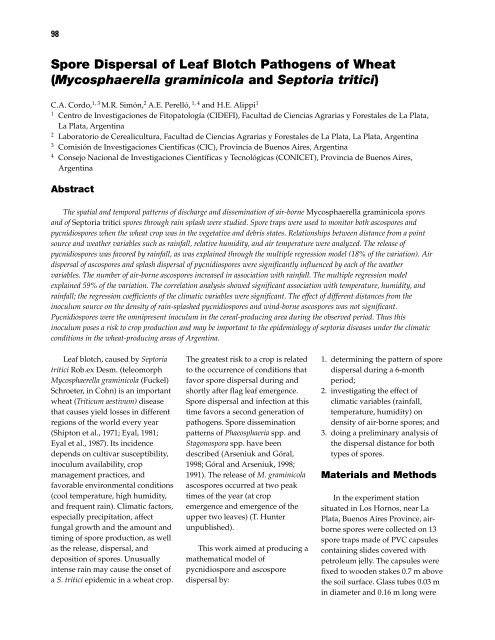Septoria and Stagonospora Diseases of Cereals - CIMMYT ...
Septoria and Stagonospora Diseases of Cereals - CIMMYT ...
Septoria and Stagonospora Diseases of Cereals - CIMMYT ...
Create successful ePaper yourself
Turn your PDF publications into a flip-book with our unique Google optimized e-Paper software.
98<br />
Spore Dispersal <strong>of</strong> Leaf Blotch Pathogens <strong>of</strong> Wheat<br />
(Mycosphaerella graminicola <strong>and</strong> <strong>Septoria</strong> tritici)<br />
C.A. Cordo, 1, 3 M.R. Simón, 2 A.E. Perelló, 1, 4 <strong>and</strong> H.E. Alippi1 1 Centro de Investigaciones de Fitopatología (CIDEFI), Facultad de Ciencias Agrarias y Forestales de La Plata,<br />
La Plata, Argentina<br />
2 Laboratorio de Cerealicultura, Facultad de Ciencias Agrarias y Forestales de La Plata, La Plata, Argentina<br />
3 Comisión de Investigaciones Científicas (CIC), Provincia de Buenos Aires, Argentina<br />
4 Consejo Nacional de Investigaciones Científicas y Tecnológicas (CONICET), Provincia de Buenos Aires,<br />
Argentina<br />
Abstract<br />
The spatial <strong>and</strong> temporal patterns <strong>of</strong> discharge <strong>and</strong> dissemination <strong>of</strong> air-borne Mycosphaerella graminicola spores<br />
<strong>and</strong> <strong>of</strong> <strong>Septoria</strong> tritici spores through rain splash were studied. Spore traps were used to monitor both ascospores <strong>and</strong><br />
pycnidiospores when the wheat crop was in the vegetative <strong>and</strong> debris states. Relationships between distance from a point<br />
source <strong>and</strong> weather variables such as rainfall, relative humidity, <strong>and</strong> air temperature were analyzed. The release <strong>of</strong><br />
pycnidiospores was favored by rainfall, as was explained through the multiple regression model (18% <strong>of</strong> the variation). Air<br />
dispersal <strong>of</strong> ascospores <strong>and</strong> splash dispersal <strong>of</strong> pycnidiospores were significantly influenced by each <strong>of</strong> the weather<br />
variables. The number <strong>of</strong> air-borne ascospores increased in association with rainfall. The multiple regression model<br />
explained 59% <strong>of</strong> the variation. The correlation analysis showed significant association with temperature, humidity, <strong>and</strong><br />
rainfall; the regression coefficients <strong>of</strong> the climatic variables were significant. The effect <strong>of</strong> different distances from the<br />
inoculum source on the density <strong>of</strong> rain-splashed pycnidiospores <strong>and</strong> wind-borne ascospores was not significant.<br />
Pycnidiospores were the omnipresent inoculum in the cereal-producing area during the observed period. Thus this<br />
inoculum poses a risk to crop production <strong>and</strong> may be important to the epidemiology <strong>of</strong> septoria diseases under the climatic<br />
conditions in the wheat-producing areas <strong>of</strong> Argentina.<br />
Leaf blotch, caused by <strong>Septoria</strong><br />
tritici Rob.ex Desm. (teleomorph<br />
Mycosphaerella graminicola (Fuckel)<br />
Schroeter, in Cohn) is an important<br />
wheat (Triticum aestivum) disease<br />
that causes yield losses in different<br />
regions <strong>of</strong> the world every year<br />
(Shipton et al., 1971; Eyal, 1981;<br />
Eyal et al., 1987). Its incidence<br />
depends on cultivar susceptibility,<br />
inoculum availability, crop<br />
management practices, <strong>and</strong><br />
favorable environmental conditions<br />
(cool temperature, high humidity,<br />
<strong>and</strong> frequent rain). Climatic factors,<br />
especially precipitation, affect<br />
fungal growth <strong>and</strong> the amount <strong>and</strong><br />
timing <strong>of</strong> spore production, as well<br />
as the release, dispersal, <strong>and</strong><br />
deposition <strong>of</strong> spores. Unusually<br />
intense rain may cause the onset <strong>of</strong><br />
a S. tritici epidemic in a wheat crop.<br />
The greatest risk to a crop is related<br />
to the occurrence <strong>of</strong> conditions that<br />
favor spore dispersal during <strong>and</strong><br />
shortly after flag leaf emergence.<br />
Spore dispersal <strong>and</strong> infection at this<br />
time favors a second generation <strong>of</strong><br />
pathogens. Spore dissemination<br />
patterns <strong>of</strong> Phaeosphaeria spp. <strong>and</strong><br />
<strong>Stagonospora</strong> spp. have been<br />
described (Arseniuk <strong>and</strong> Góral,<br />
1998; Góral <strong>and</strong> Arseniuk, 1998;<br />
1991). The release <strong>of</strong> M. graminicola<br />
ascospores occurred at two peak<br />
times <strong>of</strong> the year (at crop<br />
emergence <strong>and</strong> emergence <strong>of</strong> the<br />
upper two leaves) (T. Hunter<br />
unpublished).<br />
This work aimed at producing a<br />
mathematical model <strong>of</strong><br />
pycnidiospore <strong>and</strong> ascospore<br />
dispersal by:<br />
1. determining the pattern <strong>of</strong> spore<br />
dispersal during a 6-month<br />
period;<br />
2. investigating the effect <strong>of</strong><br />
climatic variables (rainfall,<br />
temperature, humidity) on<br />
density <strong>of</strong> air-borne spores; <strong>and</strong><br />
3. doing a preliminary analysis <strong>of</strong><br />
the dispersal distance for both<br />
types <strong>of</strong> spores.<br />
Materials <strong>and</strong> Methods<br />
In the experiment station<br />
situated in Los Hornos, near La<br />
Plata, Buenos Aires Province, airborne<br />
spores were collected on 13<br />
spore traps made <strong>of</strong> PVC capsules<br />
containing slides covered with<br />
petroleum jelly. The capsules were<br />
fixed to wooden stakes 0.7 m above<br />
the soil surface. Glass tubes 0.03 m<br />
in diameter <strong>and</strong> 0.16 m long were









